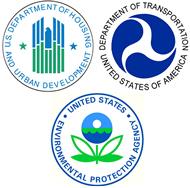HUD-DOT-EPA Partnership for Sustainable Communities

From 2009 to 2016, EPA, the U.S. Department of Housing and Urban Development (HUD), and the U.S. Department of Transportation (DOT) formed the Partnership for Sustainable Communities to help communities improve access to affordable housing and transportation while protecting the environment.
Background
On June 16, 2009, EPA joined with HUD and DOT to help improve access to affordable housing, more transportation options, and lower transportation costs while protecting the environment in communities nationwide. Through a set of guiding principles and a partnership agreement that guides the agencies' efforts, this partnership coordinated federal housing, transportation, and other infrastructure investments to protect the environment, promote equitable development, and help address the challenges of climate change.
Guiding Principles
- Provide more transportation choices. Develop safe, reliable, and economical transportation choices to decrease household transportation costs, reduce our nation's dependence on foreign oil, improve air quality, reduce greenhouse gas emissions, and promote public health.
- Promote equitable, affordable housing. Expand location- and energy-efficient housing choices for people of all ages, incomes, races, and ethnicities to increase mobility and lower the combined cost of housing and transportation.
- Enhance economic competitiveness. Improve economic competitiveness through reliable and timely access to employment centers, educational opportunities, services and other basic needs by workers, as well as expanded business access to markets.
- Support existing communities. Target federal funding toward existing communities—through strategies like transit-oriented, mixed-use development and land recycling—to increase community revitalization and the efficiency of public works investments and safeguard rural landscapes.
- Coordinate and leverage federal policies and investment. Align federal policies and funding to remove barriers to collaboration, leverage funding, and increase the accountability and effectiveness of all levels of government to plan for future growth, including making smart energy choices such as locally generated renewable energy
- Value communities and neighborhoods. Enhance the unique characteristics of all communities by investing in healthy, safe, and walkable neighborhoods—rural, urban, or suburban.
Partnership Agreement
The HUD-DOT-EPA partnership agreement stated that the agencies would:
- Enhance integrated planning and investment. The partnership will seek to integrate housing, transportation, water infrastructure, and land use planning and investment. HUD, EPA, and DOT propose to make planning grants available to metropolitan areas and create mechanisms to ensure those plans are carried through to localities.
- Provide a vision for sustainable growth. This effort will help communities set a vision for sustainable growth and apply federal transportation, water infrastructure, housing, and other investments in an integrated approach that reduces the nation's dependence on foreign oil, reduces greenhouse gas emissions, protects America's air and water, and improves quality of life. Coordinating planning efforts in housing, transportation, air quality, and water—including planning cycles, processes, and geographic coverage—will make more effective use of federal housing and transportation dollars.
- Redefine housing affordability and make it transparent. The partnership will develop federal housing affordability measures that include housing and transportation costs and other expenses that are affected by location choices. Although transportation costs now approach or exceed housing costs for many working families, federal definitions of housing affordability do not recognize the strain of soaring transportation costs on homeowners and renters who live in areas isolated from work opportunities and transportation choices. The partnership will redefine affordability to reflect those costs, improve the consideration of the cost of utilities, and provide consumers with enhanced information to help them make housing decisions.
- Redevelop underutilized sites. The partnership will work to achieve critical environmental justice goals and other environmental goals by targeting development to locations that already have infrastructure and offer transportation choices. Environmental justice is a particular concern in areas where disinvestment and past industrial use caused pollution and a legacy of contaminated or abandoned sites. This partnership will help return such sites to productive use.
- Develop livability measures and tools. The partnership will research, evaluate, and recommend measures that indicate the livability of communities, neighborhoods, and metropolitan areas. These measures could be adopted in subsequent integrated planning efforts to benchmark existing conditions, measure progress toward achieving community visions, and increase accountability. HUD, DOT, and EPA will help communities attain livability goals by developing and providing analytical tools to evaluate progress, as well as state and local technical assistance programs to remove barriers to coordinated housing, transportation, and environmental protection investments. The partnership will develop incentives to encourage communities to implement, use, and publicize the measures.
- Align HUD, DOT, and EPA programs. HUD, DOT, and EPA will work to assure that their programs maximize the benefits of their combined investments in our communities for livability, affordability, environmental excellence, and the promotion of green jobs of the future. HUD and DOT will work together to identify opportunities to better coordinate their programs and encourage location efficiency in housing and transportation choices. HUD, DOT, and EPA will also share information and review processes to facilitate better-informed decisions and coordinate investments.
- Undertake joint research, data collection, and outreach. HUD, DOT, and EPA will engage in joint research, data collection, and outreach efforts with stakeholders to develop information platforms and analytic tools to track housing and transportation options and expenditures, establish standardized and efficient performance measures, and identify best practices.
